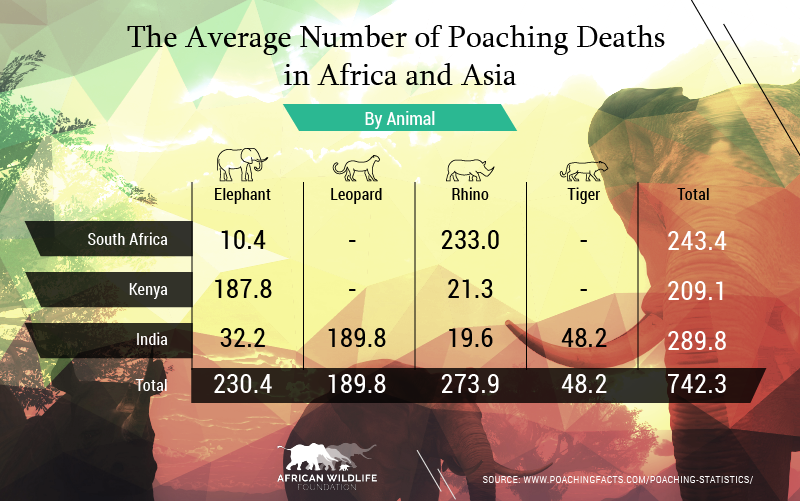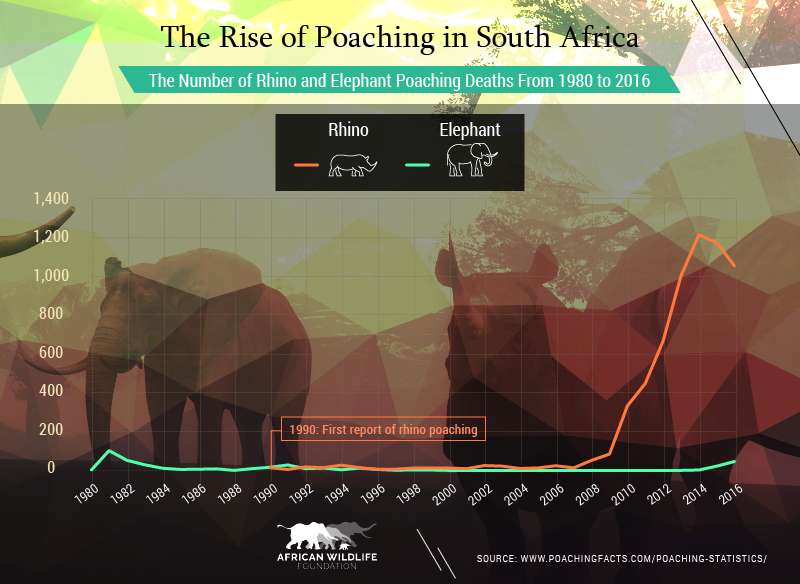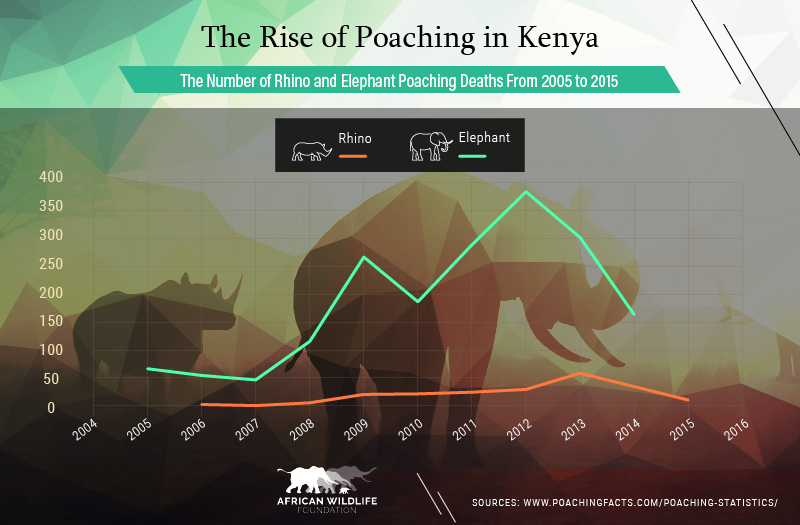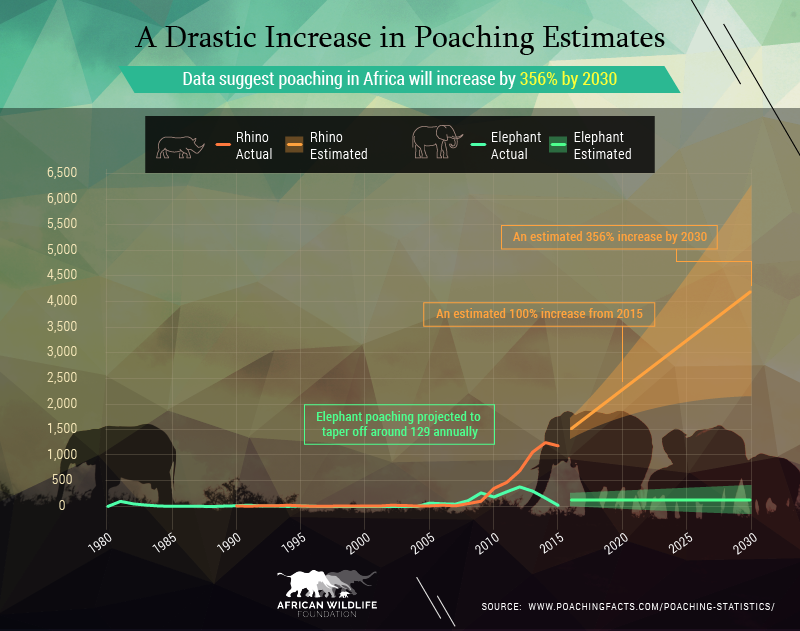
Across the globe, poaching is roundly reviled. Even legally sanctioned hunting of species has prompted an international outcry in recent years. Few understand the true scale of the problem, which persists despite escalating enforcement efforts.
In Africa alone, thousands of endangered animals die every year, killed by criminal syndicates eager to sell the spoils of their slaughter abroad. These groups strive to silence those who seek to expose their efforts, adding the assassination of conservationists to their lengthy list of crimes.
In this project, we’ve sought to explore the prevalence of poaching in statistical terms to raise the public’s awareness of the massive deaths these poachers bring about. In doing so, we’ve studied poaching rates in East Africa, South Africa, and India. Our findings show the historical scope of these poaching crimes and the pressing need to oppose them in the present.
The Poaching Toll on Two Continents

When we consider the relative rates of poaching deaths in these select countries, we find significant differences reflecting each nation’s wildlife population. Kenya is home to roughly 38,000 elephants according to recent estimates, which may account for its astronomically high rates of elephant poaching. Whereas India and South Africa are home to far fewer elephants, each boasts a relatively large – and vulnerable – species of its own. India is home to thousands of leopards, while South Africa is home to many rhinos.
In part because of its biodiversity, India has higher cumulative poaching totals than either African nation studied. When we consider the geographical scale of each country (India is larger than Kenya and South Africa combined), the intensity of the poaching problem on the African continent becomes bracingly clear. More troubling still: Many African countries have contended with poaching troubles for years.
The Death Toll of the Endangered
While the population of various endangered species varies widely across Africa, the total number of animals killed since 2005 threatens the biodiversity of the entire continent. Indeed, between January 2005 and January 2017, nearly 2,000 elephants and roughly 6,300 rhinos had been slaughtered at the hands of poachers in South Africa and Kenya alone.
While this video demonstrates steadily mounting death tolls, specific intervals saw a bloody acceleration in poaching activity. 2008 saw more than a threefold increase in rhinoceros poaching deaths over the year before, while elephant killings surged nearly 150 percent. 2010 was a similarly active poaching period, with a 238 percent uptick in rhino killings over the year prior. Sadly, elephants have been victimized more often recently, with poaching fatalities increasing more than 100 percent in 2016.
Slaughter in South Africa

South Africa’s poaching history is emblematic of the problem’s potential to accelerate dramatically in just a few years. While rates of elephant poaching have remained roughly consistent since 1980, the precipitous rise in rhino poaching is a shocking testament to poachers’ focused efforts to sell their horns abroad. Often used in Asian medicine, rhino horn is sold at rates between $15,000 and $30,000 a pound in Vietnam, the biggest hub for rhino horn export, and elsewhere, according to experts.
Many conservationists take heart in the recent decline in rhino poaching, which they attribute to an increased emphasis on enforcement. South African officials arrested 680 poachers and traffickers in 2016, which may correlate with a significant drop in rhino deaths that year. However, others are concerned about the country’s choice to re-legalize trade in rhino horns in 2017, which many say will serve to incentivize poachers in the years to come.
Endangered in the East

East Africa – home to roughly a fifth of the continent’s elephant population – has seen its gentle giants imperiled like virtually no other region in recent years. According to a recent International Union for Conservation of Nature report, East Africa’s elephant population declined by nearly half between 2006 and 2015, with Tanzania seeing a reduction of more than 60 percent during that period. While not all of these deaths are directly attributed to poaching, the region is home to particularly ruthless criminal syndicates. Anti-poaching activist Wayne Lotter was killed in Tanzania in 2017 after years spent actively opposing the country’s poachers.
Rhino poaching has also risen in East Africa, though to a lesser extent than in South Africa. Interestingly, poachers may actually be responding to government efforts to increase the legal stakes of their crimes. In 2013, prompted by a surge in rhino and elephant poaching in prior years, the Kenyan government instated severe jail terms for convicted poachers. Poaching statistics for both species have declined since.
A Frightening Future

If some nations have seen modest improvements in poaching figures, the future of threatened species remains unfortunately grim. While estimates suggest elephant poaching will remain relatively stable through 2030, the fate of rhinos seems direr. Indeed, our data suggest rhino poaching will increase by about 356 percent between 2015 and 2030.
That’s a terrifying prospect for already critically endangered species. Indeed, various types of rhinos have faced existential threats dating back centuries, from colonial-era hunting activities to the “First Rhino War,” a period of massive slaughter in the latter half of the 20th century. Accordingly, conservationists have termed the current period of rhino endangerment the “Second Rhino War,” and fear today’s poaching climate may finally cause the species’ eradication.
The Battle for Survival
If these figures reveal anything, it’s just how prevalent and problematic poaching remains in Africa and across the world. Though illegal hunters continue to imperil some of the Earth’s most beloved creatures, their crimes can be prevented through action. For all those shocked by the evils of poaching, there’s a productive way to register your outrage.
At the African Wildlife Foundation, we strive every day to defend the continent’s most vulnerable animals and natural resources. Our mission is to ensure the survival of these precious species in a modern Africa so that these beautiful creatures can be a part of the region’s future. To learn more about our work and how you can help in the fight against poaching, visit us today.
Methodology
To produce this project’s findings, we utilized data from poachingstats.com, citing figures from 1980 through the latest year available. Unless otherwise noted, our numbers refer to poaching in East and South Africa. Our projections of future poaching figures were produced with the help of the forecasting tool from Tableau, a data analysis platform.
Fair Use Statement
If you want to aid in the battle against poaching by using these graphics and figures for noncommercial purposes, we welcome your support. We ask that you simply attribute the African Wildlife Foundation appropriately with a link to this page.
Sources
- http://news.nationalgeographic.com/2016/06/cecil-african-lion-anniversary-death-trophy-hunting-zimbabwe/
- https://qz.com/921357/south-africa-is-starting-to-save-rhinos-from-poaching-by-taking-on-international-crime-networks/
- https://campaign.awf.org/poaching-infographic/
- http://www.telegraph.co.uk/news/2017/08/18/conservationist-campaigned-against-ivory-trade-shot-dead-tanzania/
- http://www.poachingfacts.com/poaching-statistics/elephant-poaching-statistics/
- http://timesofindia.indiatimes.com/home/environment/flora-fauna/Finally-India-gets-a-count-of-its-leopard-numbers-12000-14000/articleshow/48850420.cms
- https://www.awf.org/wildlife-conservation/rhinoceros
- https://www.pmfias.com/biodiversity-wildlife-india/#species-diversity
- http://www.latimes.com/world/africa/la-fg-vietnam-rhino-trafficking-20160926-snap-story.html
- http://www.npr.org/sections/goatsandsoda/2016/10/06/496846297/rhino-horn-the-most-valuable-appendage-in-illegal-wildlife-trade
- https://www.environment.gov.za/mediarelease/molewa_progressonintegrated_strategicmanagement_ofrhinoceros
- http://news.nationalgeographic.com/2017/04/wildlife-watch-rhino-horn-ban-overturned-south-africa/
- https://www.iucn.org/news/species/201609/poaching-behind-worst-african-elephant-losses-25-years-%E2%80%93-iucn-report
- https://www.nytimes.com/2017/08/18/world/africa/elephant-poachers-wayne-lotter.html?mcubz=0
- https://www.theguardian.com/environment/africa-wild/2013/jun/07/kenya-wildlife-laws-elephant-rhino-deaths
- https://voices.nationalgeographic.org/2016/09/22/rhino-wars-a-short-history-on-worldrhinoday/
- https://www.awf.org/
-
https://www.awf.org/donate